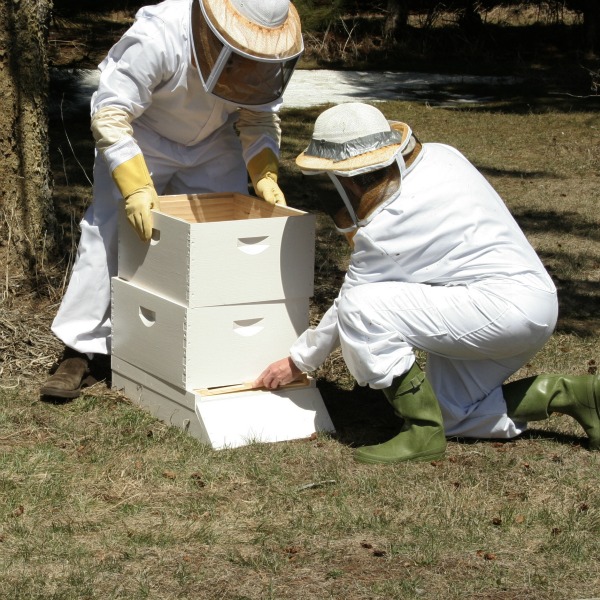 Spring 2013 officially began in Central Minnesota on April 26. Yesterday the temperature went up not just into the 50s and not just into the 60s but actually up to 72. And today, we were all ready. I’m actually relieved I didn’t have my camera with me all day. Among other things, on the way to the garden store I stumbled upon a field being plowed by teams of horses, an annual event held at different century farms each year (a farm in a single family for 100 years or more). The day ended with a complete burn of all the prairie on the farm, which is always a great spectacle.
Spring 2013 officially began in Central Minnesota on April 26. Yesterday the temperature went up not just into the 50s and not just into the 60s but actually up to 72. And today, we were all ready. I’m actually relieved I didn’t have my camera with me all day. Among other things, on the way to the garden store I stumbled upon a field being plowed by teams of horses, an annual event held at different century farms each year (a farm in a single family for 100 years or more). The day ended with a complete burn of all the prairie on the farm, which is always a great spectacle.
My day began with a call saying that the bees had arrived and could they come to the farm today? I had time to do a couple hours of gardening before Matthew Willenbring and his helper Jane Scherer arrived to set up the hives.
A few months ago, an acquaintance called and asked if he could set up two hives on our property. I’ve been wanting to learn about beekeeping for several years (bought a book and everything!). This is a great opportunity to learn about it without making a big investment. (I have to say, it’s the stuff that is holding me back.)
The friend’s partner in the beekeeping turned out to be Matthew Willenbring from Cold Spring, who I’ve written about before obliquely— he is a young dairy farmer who sells raw milk from his farm.
Hiving the bees was actually a fairly straightforward process. The biggest task was finding a place to put the hives– where they would get full sun (facing south) and be protected from the wind (windbreak to the north and west) within 1/4 mile of water. We put them at the edge of my brother-in-law’s pine grove behind the barns. Pretty much any place on our farm is close to water, and we’re sure the bees will find their way to the ample plots of wildflowers. Matthew assured us that the one time he made wildflower honey, it was the lightest, sweetest honey he ever tasted.
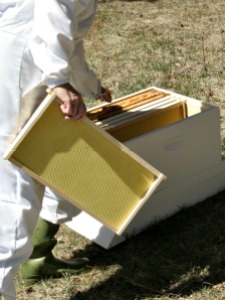 The hive boxes consist of a box called a “super” that holds 8 frames where the honey is made. In place of one (in this case two) frames is a feeder frame into which you put sugar water. The bees feed off the sugar water and build out the cells of the hive. The queen will lay eggs in them and when the flowers are ready, the bees will fill them with honey to feed the new bees and the queen.
The hive boxes consist of a box called a “super” that holds 8 frames where the honey is made. In place of one (in this case two) frames is a feeder frame into which you put sugar water. The bees feed off the sugar water and build out the cells of the hive. The queen will lay eggs in them and when the flowers are ready, the bees will fill them with honey to feed the new bees and the queen.
Matthew also had an old set of frames that still had the honey in them. Interspersing the new frames with these gives the hive a head start, as they can feed off actual honey (the sugar water is still there as a back-up). The real goal is for the bees to produce enough
honey to feed themselves (and their queen, who they will huddle around in an attempt to keep her body temp at 90 degrees) through the winter.
The bees (Italian bees with a Minnesota hygenic queen) are a combination of drones and workers and one queen. They arrive in a cage that is opened and placed into an empty box on top of the box with the trays. The queen travels in her own little cage. Her cage is opened and she is put in the top box off to the side. She will find her way down into the super and the bees will follow her (and/or find their way in through a small hole at the bottom of the frame). The only difficult moment here was when Matthew dropped the queen and had to pry her out. Otherwise, there is not really much interaction with the bees. They do buzz around, but they didn’t seem very interested in us.
More supers will be added as the bees fill them with honey, and anything above three will be available for harvesting and eating by humans. Next year, if they survive the winter, they will produce even more– and that’s when there might be enough to share with us, the landlords.
Tomorrow Matthew will come back and take out the cage. All the bees will be in the super by then. He’ll also come by with more sugar water (if they need it) and keep an eye on the progress.
We finished the day as befits a full and sudden onset of spring. Steve, Tim and Sophia set every inch of prairie on fire for a full burn all around. It’s still smoky as piles of brush burn here and there. They built up through the drought, waiting for us to get a burn permit.
Everything is officially fresh and new. Tomorrow we till the bed for the potatoes and onions…



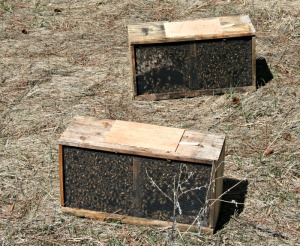
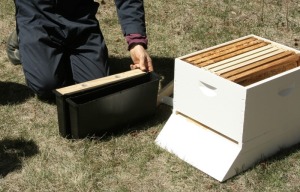
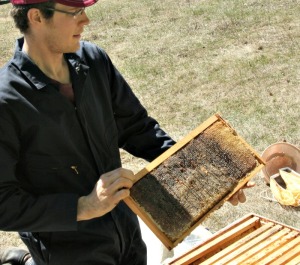
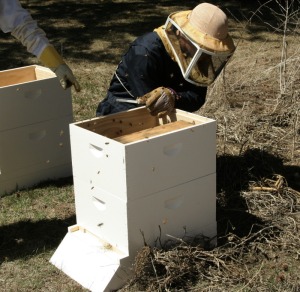
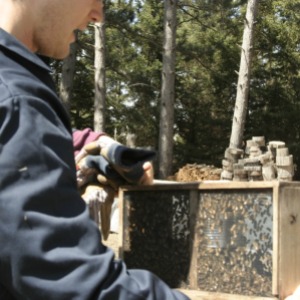
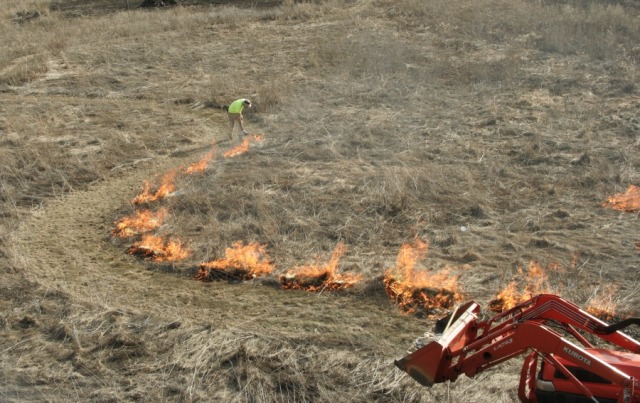
This is most interesting. Thank-you. As a kid I lived on a farm and we had bees to. I never felt the need to learn about them although we had lots of honey. Cooked a lot with it to..
I always drank raw milk, had the prettiest hands and best completion ever. Never suffered with acne. Sense leaving the farm it has been most difficult finding raw milk and my skin and finger nails show it. A cup of milk straight from the cow, we did the milking by hand in those days, was breakfast.
Thanks for the comment, Rose Mary. I’m sure the milk made a difference– and lots of fresh air and movement!
love this, such harmony: between bees, man and bees, land, man and land, man and man. You describe such purpose and expectation; a God-given order to creation. So many of us don’t ever get to see what you experience. Thank you for letting us live vicariously through your posts!
Reading your post was like spending the first day of spring with you and Steve on the farm.
It seems there is always something good happening there.
Thanks mom and Kathy! It was a good weekend!